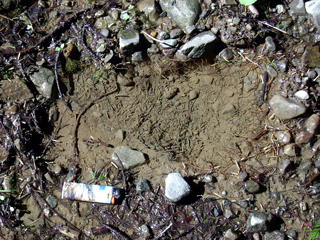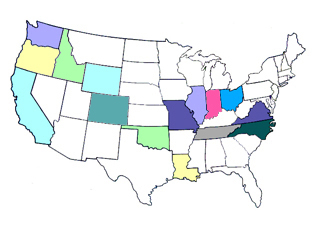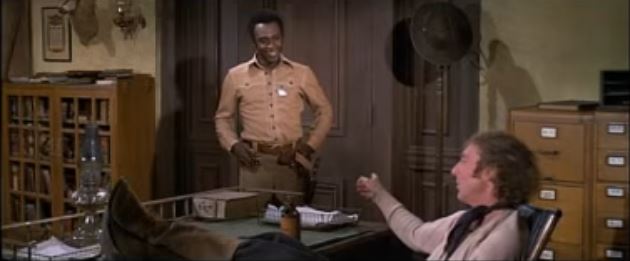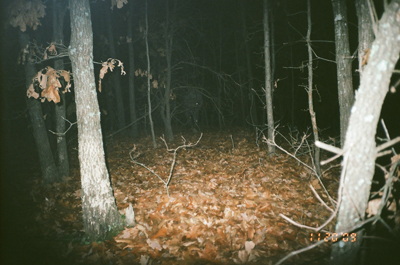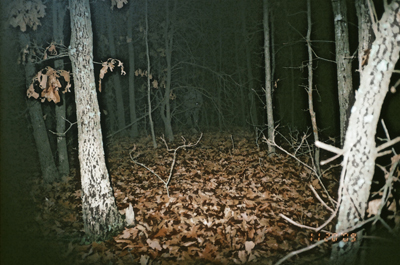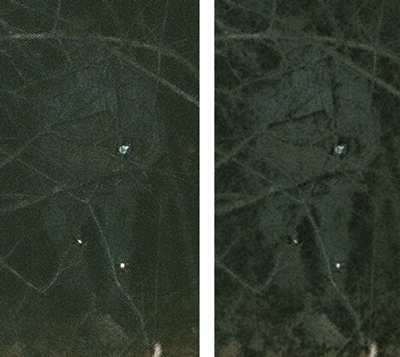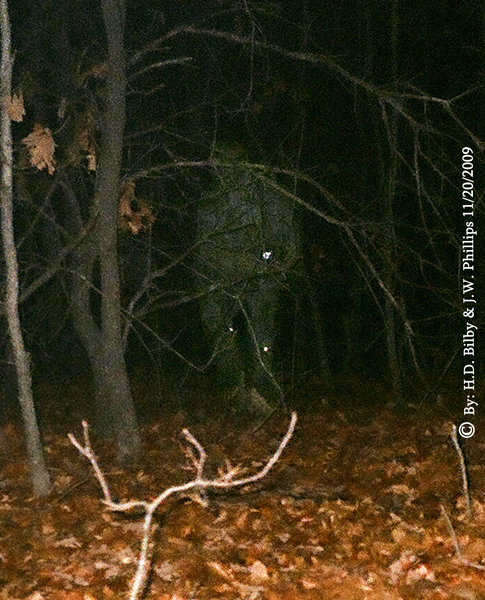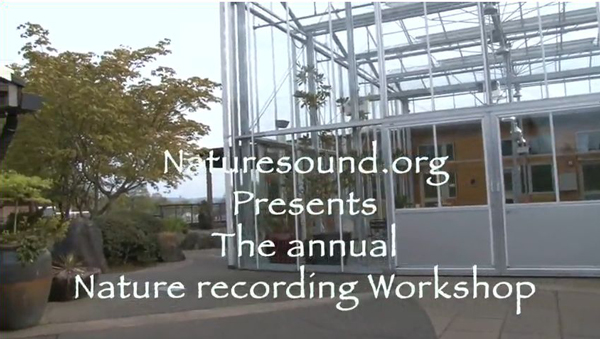Bilby-Phillips Gamecam Photo, Part 3 – Final Thoughts
Dr. Anthony Ciani
For my take of the UHS subject, it is probably a uniform color, although the pixels in the scan are about the width any camo pattern would have, which could blur the pattern across pixels, but not by much. The transparency slide I saw appeared to have no patterning at all, and looked uniform. I tried searching through some camo patterns in a couple of catalogs, and there were none which had that overall dark gray color. Almost every pattern possessed high contrasts, and very few had colors different from greens and earth tones, usually being blues. The only "gray" camo patterns were digital camos, like those used in ACUs, which are light in color. The color is very much a dark color, likely a gray, possibly a slightly silvery black, but not the jet black used in clothing. The raised foot appears to be bare. There appears to be nothing covering the face, and the area around the face looks to be a lighter color, but still grayish and dark. After studying the slide and high-res scans, it seems that the UHS itself is a dark color. The coloration of leaves hanging behind the UHS is visible, particularly red-orange tints. The scene lacks much in the way of green and blue objects. If the UHS had color, the flash appears to have been sufficient to show it. The UHS appears to be carrying another UHS, but this could be a trick due to a color variation on the UHS object itself. Still, the right arm appears to be beneath the second UHS, supporting it. The sources of the bright spots are still unclear, but may be due to dust adhering to the film, possibly during processing. These could also have been dust particles nearer to the camera when the picture was taken, although they do seem to be on the UHS. As for being a human, outside of a costume, the face appears to have characteristics which are outside normal human traits. The eyes are visible and appear large and dark. The nose also appears to have rather large nostrils. There is enough clarity to make comparisons of anatomic ratios. The legs are too short, comprising about 40% of the total height. A human leg should be 50%, or a little more. The arms are too long. If relaxed at the sides, the tip of the fist would be midway between the crotch and the knee. A human fist should be close to the crotch. The total length of the arm and fist is approximately the same as the length of the leg from the hip. The humerus to femur ratio is approximately 1.1:1, a human should be 0.7:1. The femur to tibia ratio is difficult to determine, but may be 1.2:1, which is consistent across humans and all of the great apes (although gorillas and orangs tend to have slightly longer femurs). If the subject were 5'6" tall, then the shoulders would be 27 inches across. The hips also seem wide for a human, but could be on the upper end for human females. If this is a human, it is a very deformed one. The ratios are consistent with "less evolved" apes. As for being a hoax. This does present a possibility, although difficult. To obtain the ratios measured in the image, the head of the actor would need to be beneath the head of the costume, between the large "trapezium" muscles. The shoulder width is fully outside a human capability, so the arms would be entirely prosthetic, with the actor's arms inside the torso. The hips would likely have require padding. The feet would be simple to do up. The figure is clearly not in a stable position, and so must have been walking (or anchored). It is also possible that this is a mannequin, a construction, which is easier to build for a still photo than a complicated costume. I was furnished with a Picture CD that contained all of the pictures from that film strip. There were 25 images (typical for a 24 exposure strip), and they seemed to be in order, in sets of 4, as is typical of 35mm film. The image with the UHS was at the beginning of a strip. Unless they were conveniently cut at a boundary, or the camera deactivated, there were no images of someone setting up a mannequin. There were images from the camera being setup and removed (it was relocated at one point), but not every time. Also, at some point, an additional game camera was added in the view of the first (it can be seen on a tree to the right of the UHS). No pictures were taken of that camera being setup. That second camera did take some pictures, but failed to advance the film properly. So a mannequin could have been setup, without any pictures of it, either by the owners deactivating the camera, or by hoaxers who stayed out of sensor range. As for being an unclassified ape species. No problem, if you will allow yourself to accept that such a thing has remained hidden from scientists, or scientists have been obtuse to its existence, for such a long time. Although, if you consider that such a thing only remained hidden from science for about 100 years mid 1850's until 1967), then it does not seem all that implausible, as there are species which evaded the hunter's bullet during several hundred years of exploration, on all continents. That such an animal remained hidden [from science] for 100 years seems an unimpressive feat. That science has chosen to ignore it for over 40 years, is truly disturbing. I may prefer the idea of a hoax, lest science be shamed.

